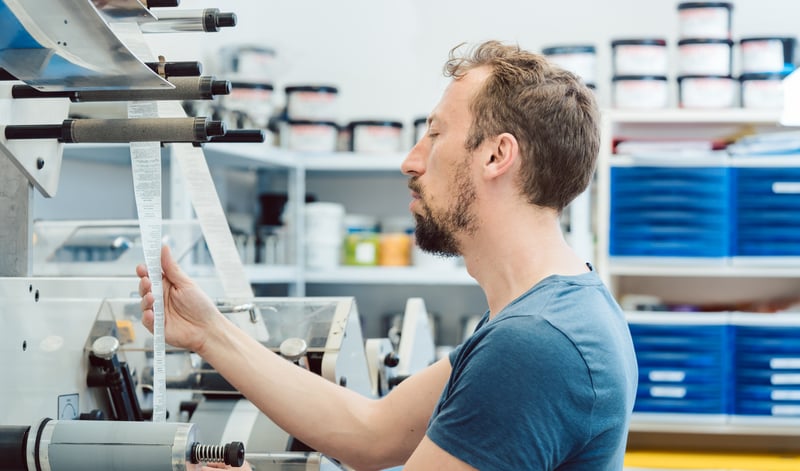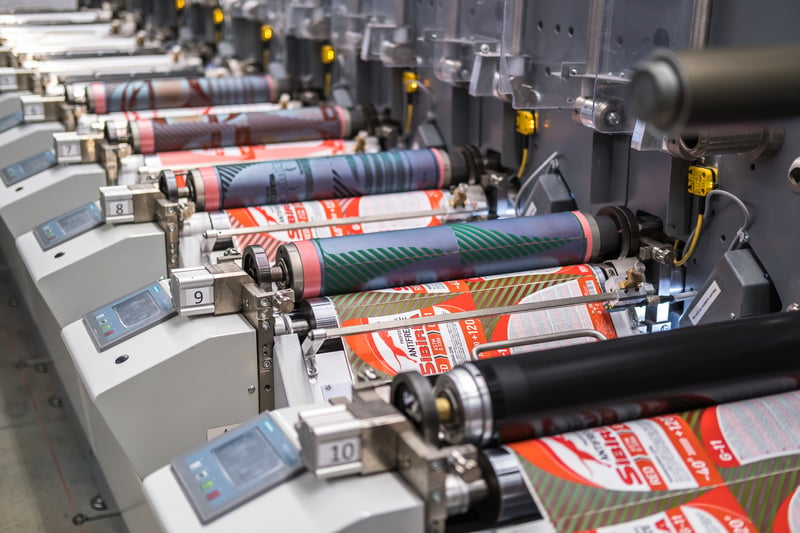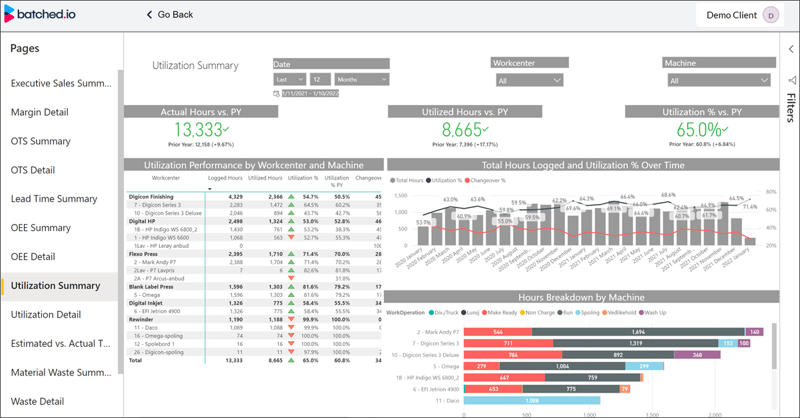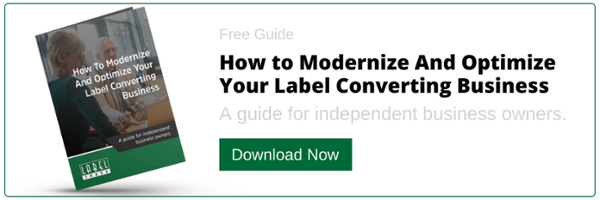How To Modernize And Optimize Your Label Converting Business
A Guide for Independent Business Owners
Background
While it’s been happening for years, the consolidation of label converting businesses is accelerating and changing the shape of the industry. It now appears to be an unstoppable force, impacting independent label converters who want to stay independent.
While the industry has traditionally been composed of smaller service providers, consolidation has created a “David and Goliath” type environment with independent label converters competing against larger organizations created by rollups and an infusion of capital.
Why is consolidation accelerating at such a rapid pace? Private equity and larger operations have identified the opportunity to increase profit margins by increasing scale. This creates a Catch-22. Independent providers find they can't compete with the cost structures of the larger businesses. And many aren't willing or don't have the capital to make additional investments to remain competitive or provide new service offerings to generate additional revenue.
While some 80% of label converter business remain independent with revenue below $5 million, it’s changing every day — especially in North America and Europe. Many of these businesses build relationships at the local level. Consolidators find it easier to buy these companies and assume these relationships to augment their broader business interests. By pooling backend resources and advancing technology, they can create cost-efficiencies that smaller operators struggle to achieve.
This, in turn, lets the large groups offer lower prices putting even more pressure on independent operators.
All4Labels, for example, has made multiple acquisitions and combined assets from family-owned label converters in the European Union. They now offer 29 production facilities globally with more than 3,000 employees. The Optimum group continues to add label converters to its rosters. In just two years, it became the most prominent label converting group in Europe.

Another trend is combining complementary businesses to broaden services. An example in the U.S. is the acquisition of Paco Level Systems by Frankston Packaging. The combined forces provide customers with label converting services and cartons and boxes in a one-stop-shop.
To stay independent, label converters must modernize and optimize their companies to compete and maintain profitability.
In this guide, we will examine some of the core issues that you need to consider, including:
• The choices you need to make about your label converter business
• Why you need to modernize your business — staying competitive and managing challenges better
• The types of modernization and how to start the process
• How to execute the modernization process in your label converter business
Choices You Make About Your Label Converting Business
For independent label converters, you have critical choices in front of you: Do you plan to stay in business and continue to serve your customers, or are you thinking about preparing for sale?
In today’s environment, it’s come down to eat or be eaten. The choice is yours.
Maintaining the status quo may work in the short term but will not provide a sustainable business model for much longer given competition created by those who have invested in modernizing their people, processes, and technology.
Leaving you with only a couple of real choices:
- Modernize and optimize your organization to compete effectively and create a sustainable business for you and your successors.
- Prepare yourself for sale, which includes modernizing and optimizing your organization for best valuation. Looking less sophisticated (i.e., maintaining a "mom and pop" operation) will severely harm your business' value.
Either way, modernization is crucial. This includes not just your in-house technology but also your processes. Large label converters are built for scale, with self-service, transparent pricing, and rapid delivery, among other benefits.
Whether you keep or sell, you can’t afford to stand still.
The good news is that there's also increased opportunity. Experts agree consumer demand for manufactured goods will drive the printed label market forward. Research from Mordor Intelligence forecasts a Compound Annual Growth Rate (CAGR) of 4.2% through 2026 for the label industry.

What Do Modernization and Optimization Mean?
Essentially, to modernize and optimize means your company can emulate a modern corporation's structures, governance, systems, and processes. Often, this means adding additional technology, infrastructure, and looking at current people and processes to see if there is a way to streamline operations, reduce costs, and prepare for scale.
Modernizing and optimizing a business is not just a theoretical exercise. Research by business consulting firm McKinsey shows that companies that digitize and transform are twice as likely to deliver revenue growth of 25% or more.
McKinsey reports that failing to modernize has significant risks and costs you up to 31% in revenue. With increased competition from larger label converters taking business from local and regional market operators, the losses may be even more significant.
Modernizing your business is not just about IT, although that’s a lot of it. It’s really an approach to add another layer of optimization to your business as a whole and increase efficiency. This includes modernizing the entire workflow across your business, including:
- Recordkeeping, accounting, tax, and legal systems
- Manufacturing Operations Management
- Enterprise Resource Management (ERP) solutions
- Customer-facing websites, applications, and self-serve tools
All solutions must be scalable to take on new opportunities as they present themselves without dramatically increasing production costs or relying on additional staffing requirements, which can reduce profitability.
Effectively modernizing your label converter business also requires defining and tracking the right metrics by developing Key Performance Indicators (KPIs) to ensure you meet your goals.
Why Should You Modernize Your Label Converting Business?
Think about what would happen to your business if one of your primary customers suddenly switched to another provider? It may surprise you to know that within the last two years, 80% of frequent buyers report they have changed suppliers for B2B services.
Why did they switch? Companies surveyed by Accenture said many suppliers had failed to modernize their businesses in ways that could meet their needs. Many providers, the survey said, remain too focused on traditional sales cycles rather than making the digital investments needed to deliver essential services on customer platforms.
Deliver on Customer Demands
Modernizing your label converter business is crucial to stay relevant and maintain customers as consumer/customer preferences change.
Here’s an example. Do you offer self-serve options for your customers or ways they can see and track work in progress? Larger companies do. If you can’t meet this customer expectation, you could be missing a large part of the market.
A Forrester study showed that 70% of B2B buyers now prefer to place orders online without human intervention. That’s only accelerated since the pandemic burst onto the scene. Customers now expect to be able to configure, price, and quote (CPQ) without having to interact with a sales rep or without waiting.
Provide Better Customer Experience
Improved customer experience = improved retention. It's a simple formula but not always easy to execute, especially given what other label converters can offer. Customer service doesn’t just mean answering the phone when the customer calls. It means meeting their expectations from their first interaction to the last. That’s why it’s now more commonly referred to as customer experience.
Typically speaking, B2B buyers want a simple and cost-efficient way to research, review, approve and purchase products.
B2B buyers want the ability to self-serve all or part of their buying journey in large numbers. TrustRadius reports that 87% of buyers want a digital experience when placing orders. It's no longer just for small transactions, either. McKinsey's research shows that 70% of B2B buyers are comfortable making fully remote purchases over $50,000, and more than a quarter would spend $500,000 without ever interacting with a salesperson or vendor offline. It stands to reason that percentages would be even higher for repeat orders.
This need will only grow as the millennial generations expand. Millennials are already the largest generation in the workforce and are largely digital natives. According to Harvard Business Review, millennials make up 73% of B2B decisions. And they expect personalized, real-time pricing, and customization.
Improved Efficiency
Efficiency is vital if you want to improve profit margins and expand the scope of work you can take on. Research by Keypoint Intelligence shows that, on average, label converters are handling 250 jobs per day that require same-day or next-day turnaround. Yet, less than one in five label converters report their operations are mostly automated. Manual processes continue to dominate the workplace and limit efficiency.
Inefficient processes incur bottlenecks, waste, and errors. The annual cost for production errors alone could exceed half a million dollars for a high-volume label converter.
Increase Business Valuations
On average, at least 70% of a small business owner's net worth is tied up in company ownership. While they may be great at bringing in new business and running a business, few have experience exiting a business. If you decide that you want to sell your label converter business or head into retirement, taking steps to increase your valuation is essential.
Modernizing and streamlining your operations can improve your margins and help you improve your business valuation. Digital workflows and smooth systems allow your business to thrive when you're no longer driving it — something investors must be confident about.
A higher valuation can also help you fend off acquisition attempts if you are in business for the long haul. The more your business is worth, the higher the price tag to buy.

Rise Above Labor Challenges
Attracting, training, and retaining good employees has always been a challenge. Employees want to work in modern, thriving businesses. Younger employees have a lot of choices today, many of which provide higher compensation and benefits. To compete effectively, you must upgrade the employee experience.
Labor looks likely to be an ongoing challenge as job openings far out way unemployed. In the U.S., for example, if every unemployed person took a job tomorrow, there would still be more than 1.4 million unfilled jobs.
Also, with retirement looming for many experienced workers, a lot of institutional knowledge is likely preparing to walk out the door shortly. Modernizing your workflow and documenting processes allows you to capture that knowledge rather than lose it forever.
Supply Chain Management
Most major raw material suppliers are currently reporting record backlogs for orders. This can be a significant challenge for smaller operators with no revenue or warehouses to support excess stock capacity. Price fluctuation, extended delivery times, and increasing freight costs present challenges for companies with outdated processes and limited resources.
Modernizing your supply chain management helps you forecast demand and inventory needs more accurately and manage your supply chain more efficiently.
The Three Types of Modernization
As mentioned, modernization is about more than just technology — although it takes technology to drive it. Three types of modernization must occur in businesses to accomplish substantial and sustainable growth:
- Organizational Modernization
- Process Modernization
- Technological Modernization
Organizational Modernization
Organizational modernization begins with creating a vision for the future. Understanding how your industry is changing and evolving allows you to envision what you need to compete effectively. This becomes the foundation to build a culture of change that can drive you forward.
Modernizing includes embracing change, ensuring your teams have the right skill sets to modernize, and you have the right workers on your team.
Most importantly, it requires a mindset and commitment to change. Often, what stops organizations from making the changes they need is fear of the unknown. Yet, failing to change and evolve is almost certainly a pathway to failure.
Process Modernization
John Chambers, CEO of Cisco, made a bold prediction in 2015. He said that at least 40% of all businesses would die in the next ten years if they didn't figure out how to change their company to accommodate new technologies. If he's right, many businesses are nearing their expiration date.
Process modernization is essential to optimize operations and maximize profits. This requires intense analysis of current business processes with an eye toward modernization and automation. Artificial intelligence, machine learning, predictive analytics, robotic process automation (RPA), and digital process automation (DPA) allow label converters to streamline workflow and improve efficiency.
For example, users of automated scheduling system batched.io have reduced material waste by up to 20%, shrunk lead times by 10% and reduced production meetings and scheduling time to brief, daily schedule reviews.
Technological Modernization
Legacy systems may be what helped bring your business to where it is today, but they may not be the right solutions to take you into the future.
Technological modernization requires a solid infrastructure to merge systems and manage your data, applications, hardware, and equipment. Everything must work seamlessly — in concert — to optimize operations.
Most label converters have already begun modernizing some of their manufacturing technology. Moving forward, they must embrace even more of a digital future by connecting disparate, fragmented islands of automation.

Starting Your Modernization Process
We’ve talked a lot about what modernization can do for your company, but now it’s time to discuss how you begin the modernization process. Here are the key steps that will help you as you plan your modernization:
- Define Success
- Take inventory of processes and systems
- List available resources
- Review your KPIs
- Talk to your customers
Define Success
To create success, you must first define it. By analyzing the current state of the marketplace, your competitors and envisioning the future, you can begin to visualize what you must do.
If possible, visit and tour a company that has completed its modernization or is well on its way. If it’s a competitor, that’s even better. You can see how they have created greater efficiencies and what they are doing to improve the buyer journey and achieve the results they want. Current partners may be able to help with introductions if you need them.
Whether you can take a tour or not, you can research online, looking into your competitors to see how they approach mission-critical processes.
Take Inventory of All Your Systems and Processes
Identifying your mission-critical applications, systems, and processes can be time-consuming, but this is a necessary exercise to establish your current workflow. By documenting your operations, you can isolate processes that require manual steps even if you don't know how (or if) you can automate them.
You may want to consider how an ERP can add value to your organization by helping to manage and integrate your financials, supply chain, operations, sales, reporting, quality management, and manufacturing processes. By combining your workflows and processes into a single platform, you gain deep insight into process mapping and identify potential hurdles more easily.
Take Inventory of All Your Available Resources
At the same time, you want to make sure you have a firm grasp on your current available resources, both from a technology and human perspective.
For example, many organizations have created procedures or set up systems that revolve around individual strengths or weaknesses in their workforce. In other cases, systems and processes may be functioning around labor shortages, skills gaps, or technology shortcomings. You must determine whether these are long-term strategies for future growth or decide to adjust to a system where success isn't dependent on a single individual.
By comparing your current workflow with what you need for success, you can identify if you have the workforce and technology tools to enable your vision for the future. This step is critical in isolating where you should invest to overcome skills gaps or modernization challenges.
Review Your Reports and KPIs
If you don’t currently have established KPIs or reporting mechanisms in place, it’s time to start. To improve performance, you need to have goals and a way to track your progress towards meeting those goals.
Some examples that are common in the label converting business include:
- Labor utilization
- On-Time Delivery
- Capacity utilization
- Manufacturing efficiency
- Profitability
As you set your KPIs, you should take a snapshot of where you are currently to establish a baseline against which you can track progress as you modernize and improve performance. It helps to take baseline measurements of these metrics and set goals for tracking.
If you need some help to understand industry trends and the performance of your peers, Label Traxx can help. With more than 400 customers globally in the label printing industry, we’ll be happy to share some of what we’ve learned.
Talk to Your Customers
To establish what your customers want from you, start by talking to them. Find out what they would like to see from you or what they're seeing from your competitors.
It may not be an easy conversation, but it is also a good idea to talk to former customers about why they chose another label converter. This kind of due diligence helps you better understand the competitive marketplace and where you failed to meet their expectations.
Now Execute!
If you're not investing now in modernizing your business, you're falling behind. 94% of all companies report undergoing some form of modernization, which is why spending on digital and system upgrades looks set to reach $1.8 trillion in 2022.
The first step in executing is to put together a "tiger team." A tiger team is a cross-functional team of experts who investigate and solve business-critical issues. Your tiger team should have representation from key areas within your organization, with outside experts/consultants filling in any knowledge gaps.
If the process feels overwhelming or complex, you may consider hiring a technology or consulting partner to manage it for you.
For the past 20 years, Label Traxx has helped hundreds of companies modernize their operations and grow their business as part of their tiger teams or managing the entire project.
We are a technology and consulting partner that works with label converting businesses to implement and integrate modern technologies. We also provide robust support and training on-site, at our training center, or via remote connection to get teams moving forward. If you're interested in learning more, request a demo and let us show you how we work.
Don't wait. Make a plan to modernize and improve the professionalism of your label converter business today.





